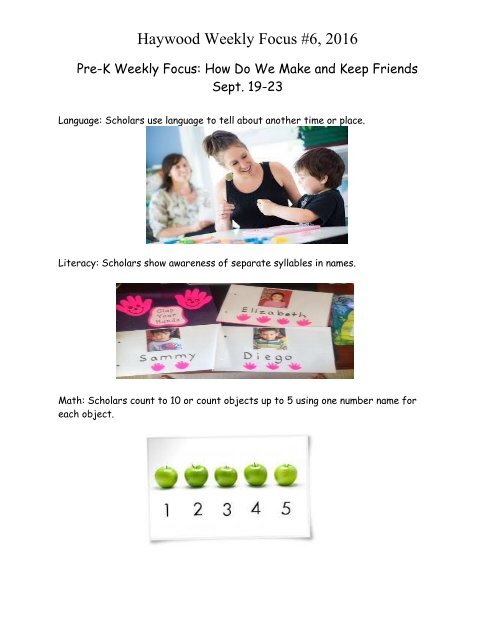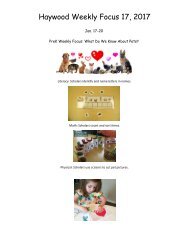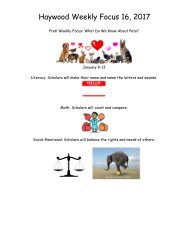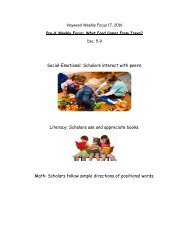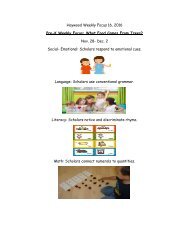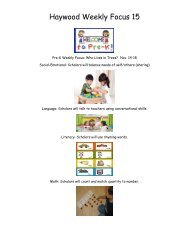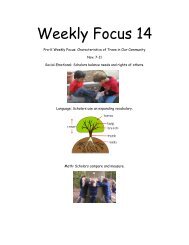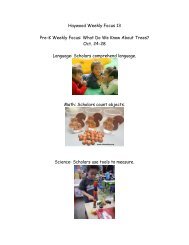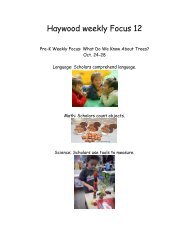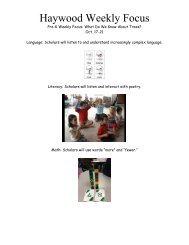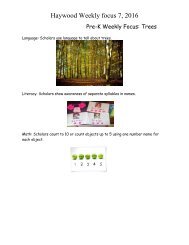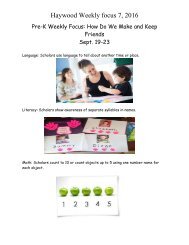You also want an ePaper? Increase the reach of your titles
YUMPU automatically turns print PDFs into web optimized ePapers that Google loves.
<strong>Haywood</strong> Weekly Focus #6, <strong>2016</strong><br />
Pre-K Weekly Focus: How Do We Make and Keep Friends<br />
Sept. 19-23<br />
Language: Scholars use language to tell about another time or place.<br />
Literacy: Scholars show awareness of separate syllables in names.<br />
Math: Scholars count to 10 or count objects up to 5 using one number name for<br />
each object.
<strong>Haywood</strong> Weekly Focus #6, <strong>2016</strong><br />
Subject<br />
RLA<br />
Kindergarten Weekly Focus September<br />
19-23<br />
Scholars will recognize rhyming words<br />
Scholars will narrate an event using pictures and words.<br />
RF.K.2 – Recognize rhyming words<br />
W.K.3 – Use drawing, dictating, and writing to narrate a single event, and tell about the<br />
event in the order in which it happened.<br />
Math<br />
Activities for home: Practice reading sight words I, like, the, and, to, see, we, and a.<br />
Practice writing first name. Find rhyming words in books or pictures.<br />
Scholars will use different ways to solve addition problems. (drawing, songs, hands, etc)
<strong>Haywood</strong> Weekly Focus #6, <strong>2016</strong><br />
K.OA.A.1- Represent addition with objects, fingers, mental images, drawings, sounds,<br />
acting out situations, verbal explanations, or equations.<br />
Activities for home: Practice adding using pictures, equations, hands, songs, etc.<br />
Social<br />
Studies<br />
Scholars will discuss Columbus Day and Christopher Columbus.<br />
K.29 – identify and describe events or people and why we celebrate them.<br />
Activities for home: Have conversations about who Christopher Columbus was.<br />
Science<br />
Scholars will observe how people change as they grow.<br />
GLE 0007.4.1 – Observe how plants and animals change as they grow.<br />
Activities for home: Practice drawing and labeling family members and talking about each<br />
one, and how people change as they grow up.
<strong>Haywood</strong> Weekly Focus #6, <strong>2016</strong><br />
Language Arts:<br />
Standards:<br />
*L.1.2d Use conventional spelling for<br />
words with common spelling patterns and<br />
for frequently occurring irregular words.<br />
*RI.1.1 Ask and answer questions about<br />
key details in text.<br />
* W.1.3 Write narratives in which they<br />
recount two or more appropriately<br />
sequenced events, include some details<br />
regarding what happened, use temporal<br />
words to signal event order, and provide<br />
some sense of closure.<br />
Objectives:<br />
*I can read and write words with<br />
short e by peeling off the word into<br />
individual letter sounds and pushing the<br />
sounds together quickly.<br />
*I can understand and retell an<br />
informational text that I have listened to<br />
or read by asking myself questions as I<br />
read or listen and using text and graphic<br />
features.<br />
* I can write a narrative that describes an<br />
event that happened in sequence by<br />
talking with a partner and using a flow<br />
map to plan my writing.<br />
Journeys Lesson 4: Lucia’s Neighborhood<br />
Strategy: Question<br />
Skill: Text and Graphic Features<br />
Fluency: Intonation<br />
Vocabulary: Alphabetical Order<br />
Writing: Narrative<br />
Grammar: Adjectives<br />
High Frequency Words:<br />
all, me, does, my, here, who<br />
Word Study: yet, web, pen, wet,<br />
leg, hen
<strong>Haywood</strong> Weekly Focus #6, <strong>2016</strong><br />
Mathematics:<br />
Unit 2: Operations and Algebraic Thinking<br />
(ends 9/23)<br />
Standards:<br />
*1.OA.C.5 Relate counting to addition and<br />
subtraction (e.g., by counting on to add 2).<br />
*1.OA.A.1 Use addition and subtraction within<br />
20 to solve word problems involving situations<br />
of adding to, taking from, putting together,<br />
taking apart, and comparing, with unknowns<br />
in all positions, e.g., by using objects,<br />
drawings, and equations with a symbol for the<br />
unknown number to represent the problem.<br />
Objective: I can compare sets of objects<br />
by making a comparing model and<br />
subtracting.<br />
Resources:<br />
Go Math 2.5: Use Pictures and Subtraction to<br />
Compare<br />
Go Math 2.6: Hands On: Subtract to Compare
<strong>Haywood</strong> Weekly Focus #6, <strong>2016</strong><br />
Science: Organisms Unit (Assessment 9/30)<br />
Standard:<br />
*GLE.0107.7.1 Realize that water, rocks, soil,<br />
living organisms, and man-made objects<br />
make up the Earth's surface.<br />
*GLE0107.T/E.1 Recognize that both natural<br />
materials and human made tools have<br />
specific characteristics that determine their<br />
use.<br />
*GLE.0107.7.2 Classify Earth materials<br />
according to their physical properties.<br />
Objective:<br />
I can classify natural (water, rocks, soil,<br />
living organisms) and man-made objects<br />
on Earth’s surface based on their physical<br />
properties by using tools to observe.
<strong>Haywood</strong> Weekly Focus #6, <strong>2016</strong>
<strong>Haywood</strong> Weekly Focus #6, <strong>2016</strong><br />
Social Studies: (Week of 9-19)<br />
Standards:<br />
*1.8 Give examples of products (goods)<br />
that people buy and use.<br />
*1.9 Give examples of services<br />
(producers) that people provide.<br />
*1.10 Explain differences between goods<br />
services and describe how people are<br />
consumers and producers of goods and<br />
services.<br />
*1.11 Describes goods and services that<br />
are exchanged worldwide.<br />
Objective:<br />
*I can give examples of goods and services<br />
and compare and contrast them by talking<br />
with a partner and using a double bubble<br />
map or Venn Diagram.<br />
Standard:<br />
*1.12 Examine different types of<br />
advertisements used to sell goods and<br />
services.<br />
Objective:<br />
*I can compare and contrast different<br />
types of advertisements used to sell<br />
goods by looking at examples of<br />
advertisements, discussing with a partner,<br />
and using a double bubble map.<br />
Standard:<br />
*1.14 Examine and analyze economic<br />
concepts including basic needs vs. wants<br />
and the factors that could influence a<br />
person to use money or save money.<br />
Objective:<br />
*I can compare and contrast basic needs<br />
and wants that people use money for by<br />
talking with a partner and using a double<br />
bubble map.<br />
Advertisement
<strong>Haywood</strong> Weekly Focus #6, <strong>2016</strong><br />
Anchor Text: “Animals Building Homes”<br />
Reading:<br />
RI.2.4 Determine the meaning of words and phrases in a text.<br />
RI.2.5 Know and use text features to locate facts and information.<br />
I can…<br />
I can ask and answer questions to clarify what I am reading.<br />
I can tell how words and photos help me to understand new information.<br />
Text or<br />
graphic<br />
feature<br />
Page #<br />
purpose
<strong>Haywood</strong> Weekly Focus #6, <strong>2016</strong><br />
Vocabulary:<br />
L.2.6 Use words and phrases acquired through conversations, reading and being read to, and<br />
responding to texts.<br />
I can use vocabulary words in a sentence.<br />
Phonics: RF.2.3 Know and apply grade-level phonics and word analysis skills in decoding words.<br />
Common Final blends: nd, ng, nt, ft, xt, mp<br />
next<br />
end<br />
camp<br />
sank<br />
sing<br />
drink<br />
hunt<br />
stand<br />
long<br />
stamp<br />
pond<br />
bring<br />
Grammar: Plural Nouns<br />
L.2.1a Use collective nouns.<br />
L.2.1b Form and use frequently occurring irregular plural nouns.<br />
Thinking Question
<strong>Haywood</strong> Weekly Focus #6, <strong>2016</strong><br />
Do I need a noun that names one or a noun that names more than one?<br />
I saw three (goose, geese).<br />
I can identify frequently used plural nouns.<br />
Writing: W.2.2 Write informative/ explanatory texts in which they introduce a topic, use facts<br />
and definitions to develop points, and provide a concluding statement or section. Paragraphs<br />
should start with a topic sentence that clearly states the main idea.<br />
Connect to Animals Building Homes<br />
“Some animals<br />
put a lot of<br />
work into<br />
building their<br />
homes.<br />
Weaver birds<br />
make nests<br />
that hang<br />
from tree<br />
branches. The<br />
birds carefully<br />
weave grass<br />
and leaves<br />
together.” (p.<br />
199)<br />
Main Idea<br />
Some animals<br />
work hard to<br />
build their<br />
homes.<br />
Supporting<br />
Detail 1<br />
Weaver birds<br />
make hanging<br />
nests.<br />
Supporting<br />
Detail 2<br />
They weave<br />
together grass<br />
and leaves.
<strong>Haywood</strong> Weekly Focus #6, <strong>2016</strong><br />
Math:<br />
2.OA.1: I can use strategies to solve addition and subtraction word problems (within 100).<br />
NBT.5: I can add and subtract two-digit numbers within 100<br />
using strategies based on place value, properties of operations, and/or the relationship<br />
between addition and subtraction.<br />
Commutative Property of Addition Example: 3 + 5 = 5 + 3<br />
Associative Property of Addition Example: (2 + 7) + 3 = 2 + (7+3)<br />
Identity Property of Zero
<strong>Haywood</strong> Weekly Focus #6, <strong>2016</strong><br />
Science:<br />
GLE 0207.7.2<br />
I can describe rocks according to their origin, size, shape, texture, and color.<br />
SCI.2.GLE 0207.Inq.1: Observe the world of familiar objects using the senses and tools.<br />
SCI.2.GLE 0207.Inq.2: Ask questions, make logical predictions, plan investigations, and represent<br />
data.<br />
SCI.2.GLE 0207.Inq.3: Explain the data from an investigation.
<strong>Haywood</strong> Weekly Focus #6, <strong>2016</strong><br />
3 rd Grade Weekly Focus September 19-23, <strong>2016</strong><br />
Subject<br />
ELA<br />
Weekly Skills to Practice<br />
This week we will be doing a lot of reviewing what we have covered over the first 9 weeks<br />
of school for are upcoming benchmark assessments. Our major strategy will be pulled from<br />
the Notice and Note area on Contrasts and Contradictions. Having students stop while they<br />
are reading and ask themselves “Why is the character doing this?”<br />
Comprehension Skill/Strategy: Text and Graphic Features /Infer & Predict<br />
Writing Focus: Students will continue to write narrative stories to identify the purpose of<br />
entertaining their reader. They will <strong>focus</strong> on meeting the main components of: who, what,<br />
when, where, why and how of a given topic or about and event or experience.<br />
Grammar Focus: Students will be comparing words using the ER and EST endings.<br />
Phonics: Teacher will work on phonics skills based upon the need to the students during<br />
small groups. Each individual student will work on needs based on DSA data.
<strong>Haywood</strong> Weekly Focus #6, <strong>2016</strong><br />
Standards: L.3.1.g Form and use comparative and superlative adjectives and adverbs, and<br />
choose between them depending on what is to be modified RF.3.3c Decode multi-syllable<br />
words L.3.2e Correctly spell grade-level appropriate high frequency words. W.3.3 Write<br />
narratives to develop real or imagined experiences or events using effective technique,<br />
descriptive details, and clear event sequences. RL.3.3 Describe characters in a story (e.g.,<br />
their traits, motivations, or feelings) and explain how their actions contribute to the sequence<br />
of events. SL.3.3 Ask and answer questions about information from a speaker, offering<br />
appropriate elaboration and detail.<br />
Additionally, students should be reading for 20 minutes each night. They should be<br />
recording what they are reading in their agenda nightly.<br />
Additionally, students should be reading for<br />
20 minutes each night. They should be<br />
recording what they are reading in their<br />
agenda nightly.<br />
Social<br />
Studies<br />
Students will be continuing in Week 6 and 7 of Studies Weekly on North America and<br />
East Tennessee. We will be identifying and distinguishing the different types of maps, their<br />
components and why they are important. This will then flow into students leaning about<br />
continents, beginning with North America.<br />
Standards: 3.14 Interpret different texts and primary sources to describe the major<br />
components of culture including language, clothing, food, art, beliefs, customs, and music.<br />
3.15 Use information gained from timelines, primary sources, media, and informational text<br />
to identify major historical events and patterns in North America.<br />
3.27 Compare and contrast landforms, climates, population, natural resources, and major<br />
cities of the three Grand Divisions of Tennessee.<br />
Science<br />
Standard: SPI 0307.2.2 Plants and Animals Competition for Resources
<strong>Haywood</strong> Weekly Focus #6, <strong>2016</strong><br />
Objective: Students will determine how living things exist amongst nonliving things.<br />
Key Vocabulary:<br />
Environment Energy Adapt/survive<br />
Ecosystem Nutrients Shelter<br />
Community Air Water<br />
Habitats are places where organisms live.<br />
Animals and plants live in the same places.<br />
Math<br />
Standards: 3.OA.A.4 Determine the unknown whole number in a multiplication or<br />
division equation relating three whole numbers. For example, determine the<br />
unknown number that makes the equation true in each equation 8 x ? = 48, 5= □ ÷<br />
3, 6 x 6 = ?.<br />
3.OA.B.6 Understand division as an unknown-factor problem. For example, find<br />
32÷8 by finding the number that makes 32 when multiplied by 8.<br />
Objective: I can find the unknown number in a multiplication or division equation<br />
by using different strategies.<br />
Unit Vocabulary<br />
Fact<br />
Family<br />
Division Dividend Divisor Quotient Equal shares<br />
Partition Equation Unknown Multiplication equal<br />
groups<br />
Inverse<br />
operation<br />
times<br />
Additionally: Students need to be practicing multiplication facts daily.<br />
Division/Multiplication Strategies:
<strong>Haywood</strong> Weekly Focus #6, <strong>2016</strong><br />
ARRAY FACT FAMILY EQUAL GROUPS<br />
Multiples<br />
Compute<br />
r<br />
Resource<br />
s<br />
News<br />
You can<br />
Use<br />
BrainPop Jr.<br />
www.brainpopjr.com<br />
Username: eaglet<br />
Password: eaglet<br />
Flocabulary<br />
www.flocabulary.com<br />
Username: westmiddlestudent4<br />
Password: westmiddlestudent4<br />
Khan Academy<br />
Learn Zillion<br />
Upcoming Dates to Remember:<br />
10/3-10/7 Fall Break; students do not report
<strong>Haywood</strong> Weekly Focus #6, <strong>2016</strong><br />
4 th Grades Weekly Focus September 12 – September<br />
23<br />
Language Arts<br />
Me and Uncle Romie<br />
Informational Text: Sidewalk Artists<br />
Weekly Focus<br />
I can understand a character using details from the story.<br />
I can recognize similarities and differences between a story character’s life and my life.<br />
Essential Question: How do an artist’s experiences affect his or her art?<br />
Cross curricular connection: Visual Arts: Collage<br />
Students may not know what a collage is – confer with art teachers, do a collage, look at<br />
other collage art in literature (Eric Carle?)<br />
Foundations<br />
CCSS.ELA-Literacy.L.4.2.d<br />
Spell grade-appropriate words<br />
correctly, consulting references as<br />
needed.<br />
Suffixes –able, -ible<br />
Standards<br />
Understanding Characters,<br />
Point of View, Theme, summarize<br />
Comprehension Strategies/Skills<br />
Grammar and Writing<br />
Narrative Writing<br />
CCSS.ELA-Literacy.L.4.2.a<br />
Use correct capitalization.<br />
CCSS.ELA-Literacy.L.4.3.a<br />
Choose words and phrases to<br />
convey ideas precisely.*
Vocabulary: Character,<br />
Point of View, Figurative<br />
Lang.<br />
CCSS.ELA-Literacy.RL.4.4<br />
Determine the meaning of<br />
words and phrases as they<br />
are used in a text, including<br />
those that allude to<br />
significant characters found<br />
in mythology (e.g.,<br />
Herculean).<br />
<strong>Haywood</strong> Weekly Focus #6, <strong>2016</strong><br />
https://www.youtube.com/watch?v=YzHYnIWg5V<br />
0<br />
CCSS.ELA-Literacy.RI.4.7<br />
Interpret information presented visually, orally, or quantitatively (e.g., in charts,<br />
graphs, diagrams, time lines, animations, or interactive elements on Web pages) and<br />
explain how<br />
the information contributes to an understanding of the text in which it appears.<br />
CCSS.ELA-Literacy.L.4.4<br />
Determine or clarify the meaning of unknown and multiple-meaning words and<br />
phrases based on grade 4 reading and content, choosing flexibly from a range of<br />
strategies.<br />
Supplemental Literature<br />
My Hands Sing the Blues<br />
Social Studies<br />
Settling the<br />
Colonies to the<br />
1700s<br />
SmartBoards lessons, Thinkpads, projects, interactive timeline, Readworks, informational text structures, thinking<br />
maps<br />
http://www.readworks.org/passages/pilgrims-puritans-pilgrim-home
<strong>Haywood</strong> Weekly Focus #6, <strong>2016</strong><br />
1620 – Readworks – the Pilgrims<br />
http://www.readworks.org/passages/american-government-mayflower-compact<br />
1620 – Readworks – the Pilgrims<br />
Pilgrims and Puritans<br />
The Pilgrim Home<br />
The Pilgrims built very simple and practical1 houses for themselves.<br />
Despite a terrible first winter, they worked hard to create homes for everyone.<br />
Until then, most of the group lived on the Mayflower, the ship that had brought them there.<br />
The first thing the Pilgrims built was the Common House. This building was twenty feet long.<br />
The Common House was first used for storage and<br />
shelter2. Eventually it was used as a hospital, church, and community meeting place.<br />
Once the Common House was built, workers had a place to rest from the cold. By April, several<br />
houses were finished. The Pilgrims were finally able to leave the Mayflower. They could start<br />
their new lives in their own homes.<br />
These homes were small. They had little or no furniture. Beds were made from bags filled with<br />
leaves, pine needles, or grass. Tables were made out of wooden planks3. People sat on<br />
benches, stools, or even on the floor.<br />
One wall of the house held a fireplace. The fireplace was used for cooking and warmth. The<br />
Pilgrims did not have glass for windows. Families would rub oil into paper or cloth and use it to<br />
cover their windows. This kept out the cold.<br />
Math<br />
Standard 4NBT6<br />
I can use strategies to divide large numbers.<br />
I can illustrate and explain my work.<br />
Learning Goal: What strategies can be used to divide large<br />
numbers?
<strong>Haywood</strong> Weekly Focus #6, <strong>2016</strong><br />
Vocabulary<br />
Compatible numbers, distributive property, divided, divisor,<br />
multiple, partial quotient, quotient, remainder.<br />
Number Talks<br />
.
<strong>Haywood</strong> Weekly Focus #6, <strong>2016</strong><br />
Science<br />
Unit- Cells
<strong>Haywood</strong> Weekly Focus #6, <strong>2016</strong><br />
Compare basic structures of plant and animal cells.<br />
Vocabulary<br />
Plant Cell, Animal Cell, Building<br />
Block, Cell Membrane, Cell<br />
Wall, Mitochondria, Nucleus,<br />
Cytoplasm, Chloroplast,<br />
Chlorophyll, Vacuole, Square,<br />
Round<br />
Building Blocks/ Supporting Standards<br />
Recognize that cells are the building blocks of all living things.<br />
Create a model of basic cells that illustrates different cell structures and their<br />
functions.<br />
Use illustrations or direct observations to compare and contrast the basic structures<br />
of plant and animal cells.
<strong>Haywood</strong> Weekly Focus #6, <strong>2016</strong>
<strong>Haywood</strong> Weekly Focus #6, <strong>2016</strong>


